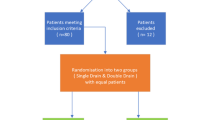Abstract
Background
There are scarce data on the factors associated with surgical site infection (SSI) among women who are discharged with a drain in situ after breast cancer surgery. The aim of this study was to determine the incidence and the factors associated with SSI in a center where women are routinely discharged with a drain in place.
Methods
A prospective cohort study included 354 women who underwent surgical treatment for breast cancer at a referral center in Rio de Janeiro, Brazil.
Results
SSI was diagnosed in 60 patients (17%) after a median follow-up of 17 days. Most infections were caused by Staphylococcus aureus. The probability of bacterial colonization of the drain was 33% on postoperative day (POD) 7 and rose to 80.8% up to the POD 14. In 83% of the cases of microbiologically documented infection, SSI was caused by the same bacterial species that had been previously isolated from the drainage fluid. In multivariate regression analyses, age 50 years (p < 0.001), skin flap necrosis (p < 0.001), and bacterial colonization of the drain (p = 0.03) were independently associated with a higher incidence of SSI.
Conclusion
The incidence of SSI among women who were routinely discharged with a drain in place was high. Older age, skin flap necrosis, and bacterial colonization of the drain were independent predictors of SSI. Modifications of the surgical technique aimed at reducing the risk of wound necrosis and early removal of the drain may contribute to lowering the risk of SSI among these patients.
Similar content being viewed by others
References
Purushotham AD, McLatchie E, Young D, et al. (2002) Randomized clinical trial of no wound drains and early discharge in the treatment of women with breast cancer. Br J Surg 89(3):286–292
Bonnema J, van Wersch AM, van Geel AN, et al. (1998) Medical and psychosocial effects of early discharge after surgery for breast cancer: randomised trial. BMJ 316(7140):1267–1271
Bundred N, Maguire P, Reynolds J, et al. (1998) Randomised controlled trial of effects of early discharge after surgery for breast cancer. BMJ 317(7168):1275–1279
Horgan K, Benson EA, Miller A, et al. (2000) Early discharge with drain in situ following axillary lymphadenectomy for breast cancer. Breast 9(2):90–92
Vilar-Compte D, Jacquemin B, Robles-Vidal C, et al. (2004) Surgical site infections in breast surgery: case-control study. World J Surg 28(3):242–246
Vilar-Compte D, Roldan-Marin R, Robles-Vidal C, et al. (2006) Surgical site infection (SSI) rates among patients who underwent mastectomy after the introduction of SSI prevention policies. Infect Control Hosp Epidemiol 27(8):829–834
Bonnema J, van Wersch AM, van Geel AN, et al. (1998) Cost of care in a randomised trial of early hospital discharge after surgery for breast cancer. Eur J Cancer 34(13):2015–2020
Gaynes RP, Culver DH, Horan TC, et al. (2001) Surgical site infection (SSI) rates in the United States, 1992–1998: the National Nosocomial Infections Surveillance System basic SSI risk index. Clin Infect Dis 33(Suppl 2):S69–S77
Garner JS, Jarvis WR, Emori TG, et al. (1988) CDC definitions for nosocomial infections, 1988. Am J Infect Control 16(3):128–140
Skov T, Deddens J, Petersen MR, et al. (1998) Prevalence proportion ratios: estimation and hypothesis testing. Int J Epidemiol 27(1):91–95
Deo SV, Shukla NK, Goel AK, et al. (1997) Short stay surgery for breast cancer: an audit of an experience in a regional cancer centre in northern India. Eur J Surg Oncol 23(4):335–338
Bertin ML, Crowe J, Gordon SM (1998) Determinants of surgical site infection after breast surgery. Am J Infect Control 26(1):61–65
Rotstein C, Ferguson R, Cummings KM, et al. (1992) Determinants of clean surgical wound infections for breast procedures at an oncology center. Infect Control Hosp Epidemiol 13(4):207–214
Hoefer RA Jr, DuBois JJ, Ostrow LB, et al. (1990) Wound complications following modified radical mastectomy: an analysis of perioperative factors. J Am Osteopath Assoc 90(1):47–53
Ruvalcaba-Limon E, Robles-Vidal C, Poitevin-Chacon A, et al. (2006) Complications after breast cancer surgery in patients treated with concomitant preoperative chemoradiation: a case-control analysis. Breast Cancer Res Treat 95(2):147–152
Sorensen LT, Horby J, Friis E, et al. (2002) Smoking as a risk factor for wound healing and infection in breast cancer surgery. Eur J Surg Oncol 28(8):815–820
Terrell GS, Singer JA (1992) Axillary versus combined axillary and pectoral drainage after modified radical mastectomy. Surg Gynecol Obstet 175(5):437–440
Baas-Vrancken Peeters MJ, Kluit AB, Merkus JW, et al. (2005) Short versus long-term postoperative drainage of the axilla after axillary lymph node dissection: a prospective randomized study. Breast Cancer Res Treat 93(3):271–275
Dalberg K, Johansson H, Signomklao T, et al. (2004) A randomised study of axillary drainage and pectoral fascia preservation after mastectomy for breast cancer. Eur J Surg Oncol 30(6):602–609
Felippe W (2003) Perfil da infecção do sítio cirúrgico em unidade de mastologia oncológica. Rev Enfermagem UERJ 11(1):11–17
Schwartz GF, Giuliano AE, Veronesi U (2002) Proceedings of the consensus conference on the role of sentinel lymph node biopsy in carcinoma of the breast April 19 to 22, 2001, Philadelphia, Pennsylvania. Hum Pathol 33(6):579–589
Burak WE, Hollenbeck ST, Zervos EE, et al. (2002) Sentinel lymph node biopsy results in less postoperative morbidity compared with axillary lymph node dissection for breast cancer. Am J Surg 183(1):23–27
Schulze T, Mucke J, Markwardt J, et al. (2006) Long-term morbidity of patients with early breast cancer after sentinel lymph node biopsy compared to axillary lymph node dissection. J Surg Oncol 93(2):109–119
Acknowledgment
This study was partially supported by CAPES.
Author information
Authors and Affiliations
Corresponding author
Additional information
This study was partially supported by CAPES.
Rights and permissions
About this article
Cite this article
Felippe, W.A.B., Werneck, G.L. & Santoro-Lopes, G. Surgical Site Infection Among Women Discharged with a Drain In Situ After Breast Cancer Surgery. World J Surg 31, 2293–2299 (2007). https://doi.org/10.1007/s00268-007-9248-3
Published:
Issue Date:
DOI: https://doi.org/10.1007/s00268-007-9248-3




